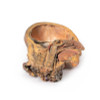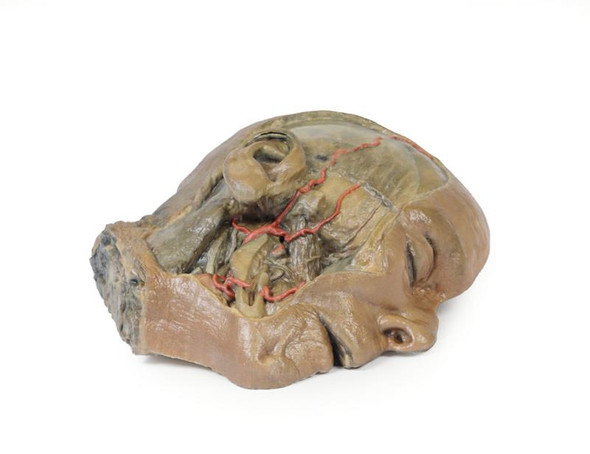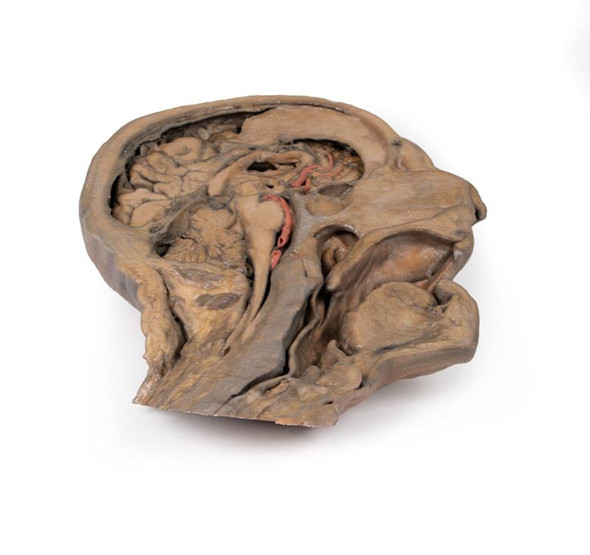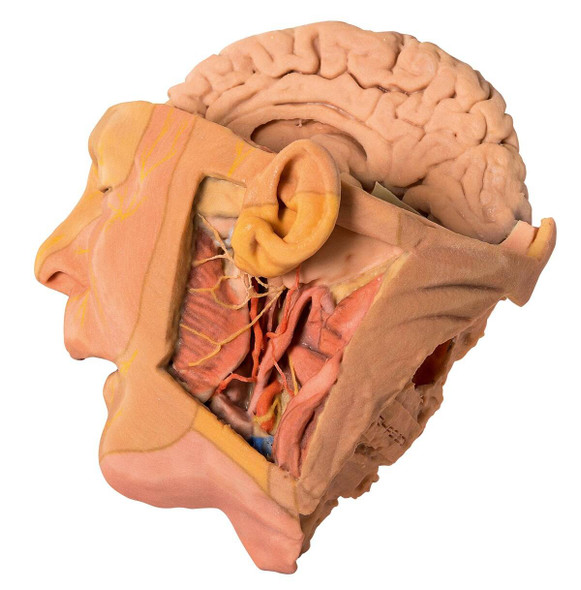- Home
- Brands
- Erler Zimmer
- 3D Printed Sagittal Section of Head and Neck with Infratemporal Fossa and Carotid Sheath Dissection
Description
This 3D model provides a complimentary specimen to the H11 and H12 head and neck specimens by providing a perspective of the endocranial cavity without the brain, and a lateral dissection inclusive of neck anatomy.
In the midsagittal section, the removal of the brain (and reflection of the medulla oblongata inferiorly) affords a full view of the dura mater lining the endocranial cavity, including the tentorium cerebelli spanning from the transverse sinus to the attachment to the clinoid process of the sphenoid. A series of cranial nerves, including the optic (CN II), oculomotor (CN III), trigeminal (CN V), the abducens (CN VI) and the combined facial (CN VII) and vestibulocochlear (CN VIII) nerves can be seen piercing the dura. The pituitary gland can be seen in cross-section within the sella turcica, and the left vertebral artery can be seen ascending in the posterior cranial fossa.
The lateral dissection to the face has retained some superficial structures while simultaneously exposing the anatomy within the infratemporal fossa. The facial vein and facial artery have been preserved but are dissected away from any superficial fascia or muscles of facial expression and lie across the corpus of the mandible and buccinator muscle. Most of the ascending ramus of the mandible and the zygomatic arch have been removed to demonstrate some of the infratemporal fossa anatomy, including the inferior alveolar artery and nerve and lingual nerve (resting on the medial pterygoid), the posterior deep temporal artery (resting on the lateral pterygoid), and the articulation of the mandibular condyle with the glenoid fossa. The terminal part of the external carotid artery is visible, as is the first part of the maxillary artery and the superficial temporal artery.
Posterior to the infratemporal region, the facial nerve (CN VII) can be seen briefly adjacent to the posterior belly of the digastric muscle. The posterior belly of the digastric angles superficially to obscure the internal and external carotid arteries and the internal jugular vein, which have been dissected from the carotid sheath (alongside the vagus nerve [CN X]). At the angle of the mandible, and along the inferior margin of the corpus, the hypoglossal nerve (CN XII) rests just adjacent to the central tendon of the digastric and the external carotid artery. Anteriorly, the facial artery is integrated into the submandibular gland before ascending across the mandibular corpus, where the lingual artery and anterior belly of the digastric can be observed. A set of superficial veins descend inferiorly into the neck as a presumptive external jugular vein (although displaced given the removal of the retromandibular vein and sternocleidomastoid muscle, it is too posterior to be an anterior jugular vein).
In the neck region of the specimen, the hyoid bone is immediately deep to the submandibular gland and receives infrahyoid muscles just superficial to a robust thyroid gland. At the cut section of the dissection inferiorly, the underlying larynx can also be observed. Posterior to the carotid sheath structures, radiating cutaneous branches from the cervical plexus rest on the scalene muscles, and near the inferior margin of the specimen the upper roots of the brachial plexus are preserved adjacent to the exposed internal jugular vein.
Advantages
- Anatomically accurate and identical to real specimen
- No ethical issues - not real human body parts
- Reasonably priced
- Available within a short lead time
- Reproducible, several identical prints can be used as a classroom set
- Can be produced in different sizes to cater for the needs of the teacher
Human Cadavers
- Access to cadavers can be problematic. Many countries cannot access cadavers for cultural and religious reasons
- Cadavers cost a lot money
- High cost for establishing your own plastination suite
- Wet specimens cannot be used in uncertified labs
- Dissection of cadavers is a lot of staff time and that is a cost
- Storage of cadaver material needs special refrigeration etc. which has coast
- If you want another specimen you have to start all over again
Plastinates
- Costs
- Ethical issues
- Timeframe for plastination process
- Many countries do not allow their importation
- One of a kind
Superior 3D print results compared with conventional methods
- Vibrant color offering with 10 million colors
- UV-curable inkjet printing
- High quality 3D printing that can create products that are delicate, extremely precise and incredibly realistic
Clear Support Material
- To avoid breakage of fragile, thin, and delicate arteries, veins or vessels, a clear support material is printed on such spots. This makes the models robust and can be handled by students easily.






























